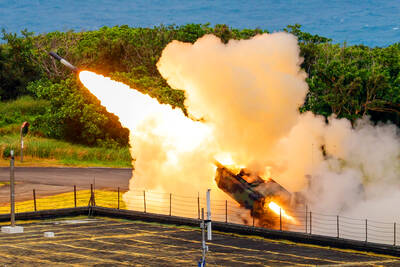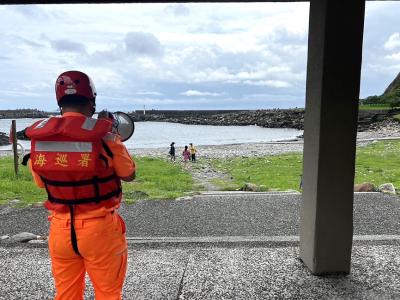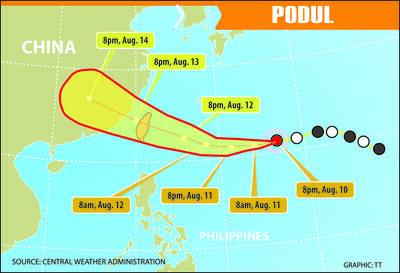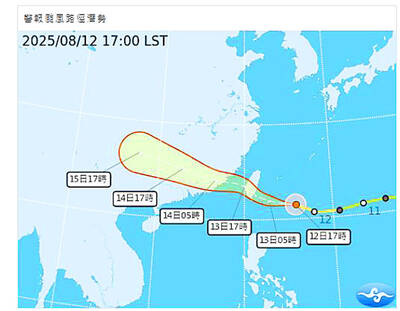Beijing is willing to use force to achieve its political goals, and although China's military does not yet have the ability to conquer Taiwan, especially if other countries intervene in a cross-strait conflict, the military gap between the two nations is widening, the Pentagon said in a report released yesterday.
In addition to Chinese efforts to create a modern military, the report cited Taiwan's lack of progress in military procurement as a major problem.
The report also warned of the possibility that the Chinese Communist Party could, nevertheless, lead China into a war through overconfidence or desperation caused by internal upheavals.
The US Department of Defense's annual report to Congress on "The Military Power of the People's Republic of China" was released yesterday after weeks of internal government wrangling over various details included in the document.
The report highlights the growing concern among US officials over China's rapid modernization of its military forces and pugnacity regarding Taiwan, as well as frustration over the special arms budget bill that has been blocked by the pan-blues in the legislature.
"Taiwan's defense spending has steadily declined in real terms over the past decade, even as Chinese air, naval, and missile force modernization has increased the need for countermeasures that would enable Taiwan to avoid being quickly overwhelmed," the report said.
The report also, on two separate occasions, points out that the NT$410.8 billion (US$15 billion) special arms budget -- which would allow Taiwan to purchase eight diesel-electric submarines, 12 P-3C Orion maritime patrol aircraft and three PAC-3 Patriot anti-missile batteries from the US -- is awaiting approval by the Legislative Yuan.
Meanwhile, China was becoming ever stronger, the report said.
"The cross-strait military balance appears to be shifting toward Beijing as a result of China's sustained economic growth, growing diplomatic leverage, and improvements in the PLA's [People's Liberation Army] military capabilities, including those that provide Beijing options short of full-scale invasion," the Pentagon said in the report.
"Beijing continues to see the threat and possible use of force as integral to its policy of dissuading Taiwan from pursuing independence and moving Taiwan ultimately to unite with the mainland," the report said.
However, it also said that a military strike against Taiwan would most likely not accomplish Beijing's stated goal of unification.
"China does not yet possess the military capability to accomplish with confidence its political objectives on the island, particularly when confronted with outside intervention," the report said.
"Outside intervention" would almost certainly be in the form of US and Japanese military action, according to the report.
"Beijing sees Washington and, increasingly, Tokyo as the principal hurdles to any attempt to use military force to coerce or capture Taiwan," the report said. Therefore, "Beijing will pursue diplomatic efforts to keep the United States and Japan from taking action to support Taiwan."
Although China has made significant advances in its military capabilities over the past decade, there were still serious deficiencies in its capabilities and overall structure, the report said.
But that would change with time, it said.
"The US intelligence community estimates that China will require until the end of this decade or later for its military modernization program to produce a modern force, capable of defeating a moderate-size adversary," the report said.
China is estimated to spend between US$50 billion and US$70 billion a year on its military budget, making it the third largest defense spender in the world. The US, which spends more money on defense than any other nation, has a military budget of approximately US$400 billion.
One of the key goals to China's military transformation is to thwart intervention by the US or other countries in the Taiwan Strait, the Pentagon said.
"Preventing foreign military intervention, particularly along China's coast, has been a goal for Beijing throughout history, reinforcing the geostrategic value of Taiwan for China's security planners," the report said.
Currently, Beijing does not appear to be contemplating military action against Taiwan, primarily because of two factors: Lack of military capabilities and "potential repercussions of any use of force against Taiwan."
One of those repercussions would be severe, long-term damage to China's economy, in part because Taiwan is the authoritarian giant's largest source of foreign direct investment.
Still, the report said, there was plenty of room for the Chinese Communist Party to miscalculate its military capabilities and the international situation, thus leading to a cross-strait conflict involving the US and Japan.
"China's leaders may overestimate the proficiency of their forces," the report said.
"Beijing could use limited strikes, employing information operations, special operations forces on Taiwan, and SRBM [Short-range Ballistic Missiles] or air strikes at key military or political sites, to try to break the will of Taiwan's leadership and population," the Pentagon wrote.
"Although Beijing might view these as a complement to non-military coercion and as less than a full use of force, others may view such actions differently," it said.
"Such a Chinese miscalculation could lead to a full-fledged conflict."

DEFENSE: The first set of three NASAMS that were previously purchased is expected to be delivered by the end of this year and deployed near the capital, sources said Taiwan plans to procure 28 more sets of M-142 High Mobility Artillery Rocket Systems (HIMARS), as well as nine additional sets of National Advanced Surface-to-Air Missile Systems (NASAMS), military sources said yesterday. Taiwan had previously purchased 29 HIMARS launchers from the US and received the first 11 last year. Once the planned purchases are completed and delivered, Taiwan would have 57 sets of HIMARS. The army has also increased the number of MGM-140 Army Tactical Missile Systems (ATACMS) purchased from 64 to 84, the sources added. Each HIMARS launch pod can carry six Guided Multiple Launch Rocket Systems, capable of

Tropical Storm Podul strengthened into a typhoon at 8pm yesterday, the Central Weather Administration (CWA) said, with a sea warning to be issued late last night or early this morning. As of 8pm, the typhoon was 1,020km east of Oluanpi (鵝鑾鼻), Taiwan’s southernmost tip, moving west at 23kph. The storm carried maximum sustained winds of 119kph and gusts reaching 155kph, the CWA said. Based on the tropical storm’s trajectory, a land warning could be issued any time from midday today, it added. CWA forecaster Chang Chun-yao (張竣堯) said Podul is a fast-moving storm that is forecast to bring its heaviest rainfall and strongest

TRAJECTORY: The severe tropical storm is predicted to be closest to Taiwan on Wednesday and Thursday, and would influence the nation to varying degrees, a forecaster said The Central Weather Administration (CWA) yesterday said it would likely issue a sea warning for Tropical Storm Podul tomorrow morning and a land warning that evening at the earliest. CWA forecaster Lin Ting-yi (林定宜) said the severe tropical storm is predicted to be closest to Taiwan on Wednesday and Thursday. As of 2pm yesterday, the storm was moving west at 21kph and packing sustained winds of 108kph and gusts of up to 136.8kph, the CWA said. Lin said that the tropical storm was about 1,710km east of Oluanpi (鵝鑾鼻), Taiwan’s southernmost tip, with two possible trajectories over the next one

GET TO SAFETY: Authorities were scrambling to evacuate nearly 700 people in Hualien County to prepare for overflow from a natural dam formed by a previous typhoon Typhoon Podul yesterday intensified and accelerated as it neared Taiwan, with the impact expected to be felt overnight, the Central Weather Administration (CWA) said, while the Directorate-General of Personnel Administration announced that schools and government offices in most areas of southern and eastern Taiwan would be closed today. The affected regions are Tainan, Kaohsiung and Chiayi City, and Yunlin, Chiayi, Pingtung, Hualien and Taitung counties, as well as the outlying Penghu County. As of 10pm last night, the storm was about 370km east-southeast of Taitung County, moving west-northwest at 27kph, CWA data showed. With a radius of 120km, Podul is carrying maximum sustained